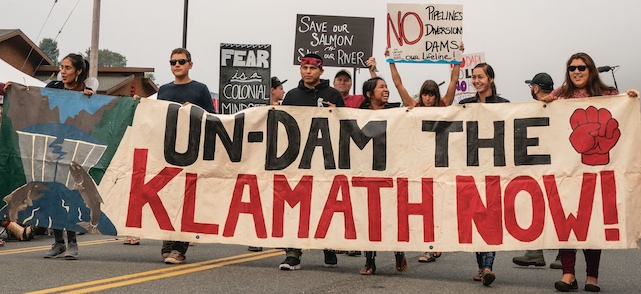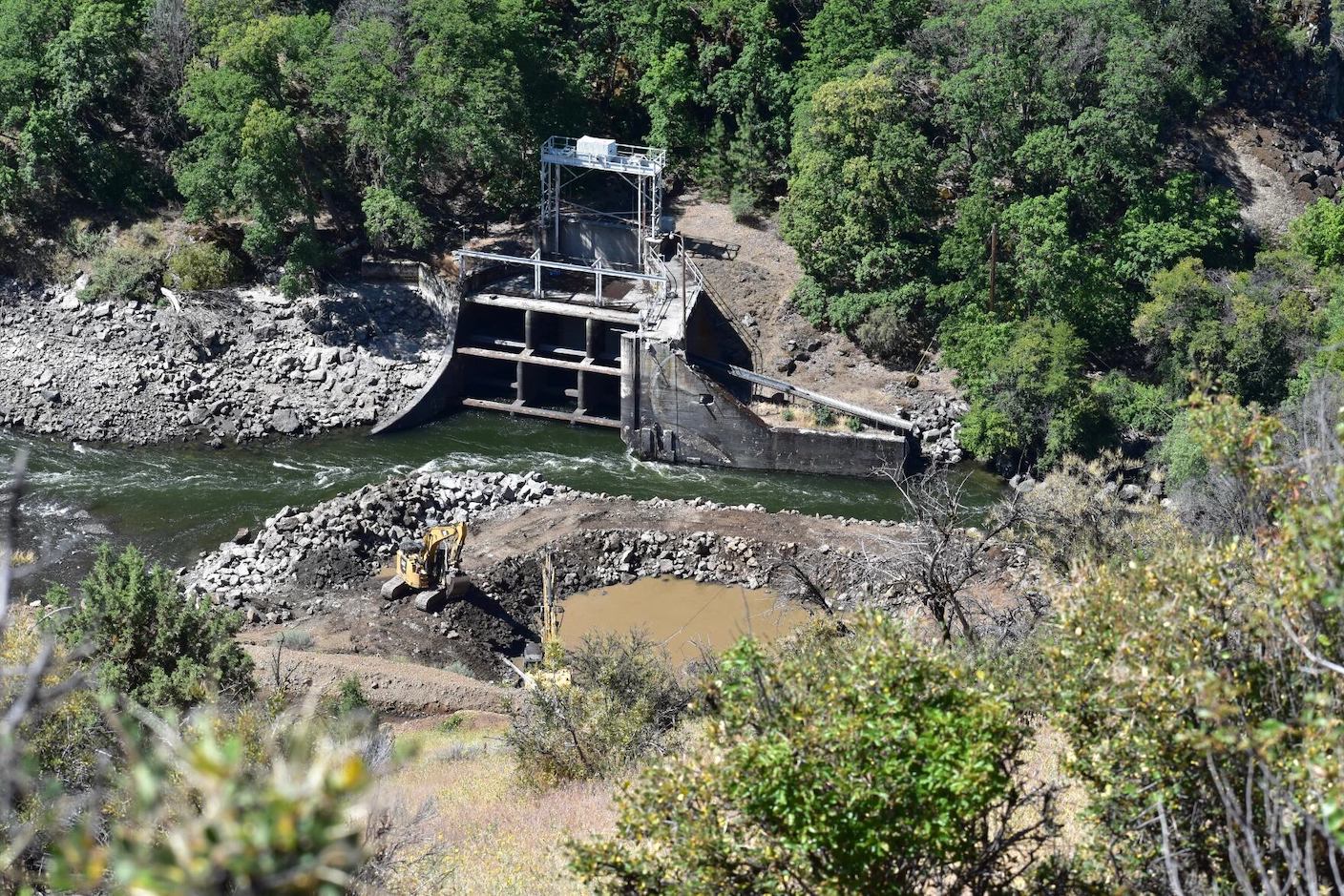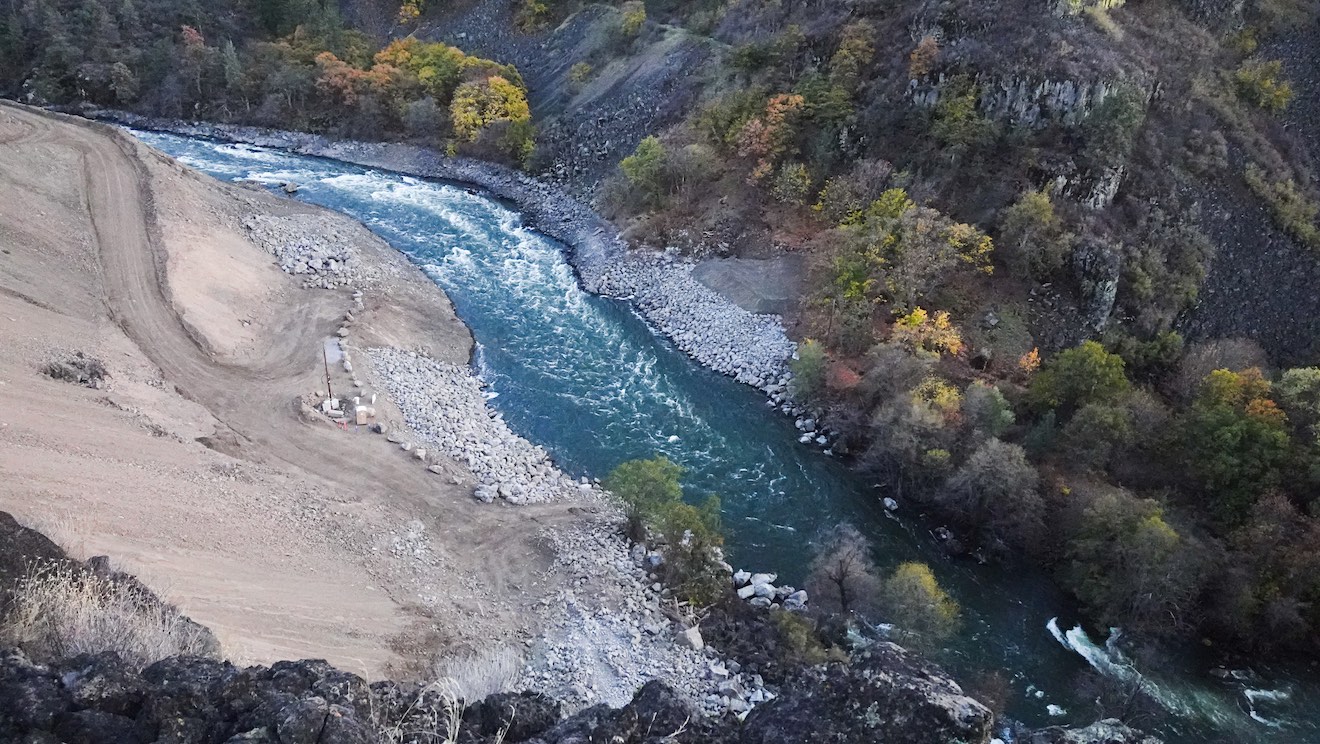
West |
Central |
East |

With One Down, Klamath Dam
Removal Proceeds on Schedule
-- Oregon Public Broadcasting by Juliet Grable, July 16, 2023Removing the Copco 2 Dam takes deconstruction crews one step closer to drawdowns of the remaining three reservoirs next January.
The first of four hydroelectric dams along the Oregon-California border has been removed from the main stem of the Klamath River. All that remains of the dam known as Copco 2 in Siskiyou County, California, is the headworks of a diversion tunnel adjacent to the now free-flowing river.
"As little as a month ago, it was a 35-foot concrete dam that spanned the entire width of the Klamath River right there," says Mark Bransom, CEO for the Klamath River Renewal Corporation, which is overseeing dam removal.
From a nearby overlook of red volcanic rock, an excavator looks like a child's toy as it chips away at the remnants of the concrete wall that was embedded in the river.
When complete, the overall project will be the biggest dam removal in U.S. history and will reopen 400 miles of fish habitat that was cut off for more than a century.
Deconstruction activities on Copco 2 will continue until September. Getting this first dam out of the way takes deconstruction crews one step closer to drawdowns of the remaining three reservoirs next January.
Who's doing the work?
Last December, the Klamath River Renewal Corporation took over the license of the Lower Klamath Hydroelectric Project from PacifiCorp, the utility that owned and operated it. The nonprofit KRRC, which formed expressly to oversee dam removal, is responsible for hiring contractors and complying with the many federal and state permits required to do this massive project. PacifiCorp will continue to operate the power plants as needed until they are decommissioned.
Kiewit, a national construction company, is the lead contractor for the deconstruction of the dams and associated infrastructure. The company will hire upwards of 250 to 300 workers once the project ramps up and has already selected a number of local and tribal subcontractors.
Resource Environmental Solutions, or RES, is responsible for propagating millions of seeds and revegetating the reservoir footprints with native plants. Crews from the Yurok Tribe are already collecting seeds and weed-whacking invasive plants near the reservoir shores.
What's happening next?
For the next several months, Kiewit will lay the groundwork for the drawdowns. Soon, crews staged at the base of Copco 1 Dam will "drill and shoot" a 10-foot diameter outlet tunnel through the concrete structure.
"The contractor will leave about a 10- to 12-foot plug of concrete that will sit there until early January of next year," says Bransom. Come January, they'll blast through the rest of the tunnel, effectively pulling the plug and allowing water and sediment to pour through the opening.
At Iron Gate, the lowest of the four dams, crews are testing the existing outlet tunnel to make sure it's ready for the critical job it will have to do -- that of a massive bathtub drain.
"So all the water from J.C. Boyle, all of the sediment accumulated there on the Oregon side, all of the water and all of the sediment behind Copco Number 1, and all of the water and all the sediment behind Iron Gate Dam are going to come out of that hole right there," says Bransom. "That is the final control point, if you will, for the drawdown of the remaining three [dams]."
While this work takes place, the reservoirs are being carefully managed to ensure enough water flows downstream to support coho salmon, as required by federal fish agencies.
"The Bureau of Reclamation has a biological opinion that requires them to ensure that a certain amount of water always flows below Iron Gate Dam all the way down the river," says Bransom. "So what we've had to do, in close coordination with the Bureau of Reclamation, tribes and others, is to overlay our construction operational requirements on top of those regulatory requirements."
When will the reservoirs go away?
Starting next January, three reservoirs behind the remaining three dams will be drawn down at a rate of about five feet per day.
"We never want to have so much water coming through these outlet tunnels that we create a dam safety condition," says Bransom. "And the second thing is we never want to overtop the riverbank."
An estimated 20 million cubic yards of sediment has accumulated behind the dams over the last century; Bransom says about 5 to 7 million cubic yards of that will wash out during the drawdowns.
Crews will use fire hoses to blast sediment from especially steep slopes near the rims of the former reservoirs to prevent future erosion into the river.
To best protect fish from the muddy water, the drawdowns will take place in winter, with a pause in April to allow young coho salmon to migrate out to the ocean. The reservoirs could partially refill with spring snowmelt, but by June the Klamath River should be flowing freely through the newly open outlet tunnels in the dams.
Though it will temporarily impair water quality in the river, the movement of sediment is an important part of healthy river systems, says Bransom. "And the Klamath has been starved of that natural process since these dams were constructed."
How will the other dams be removed?
Once the drawdowns are complete, the remaining three dams will be taken down all at the same time, starting next June.
The deconstruction method will be tailored to each structure. At Iron Gate, excavators will bite chunks out of the massive earthen dam and feed them to an endless convoy of dump trucks. At Copco 1, crews will drill small holes in the base of the dam and pack them with dynamite -- not to create a massive explosion, but to break the monolithic structure into more manageable chunks that can be hauled away. They'll also remove a portion of the deep concrete foundation to ensure it doesn't ever pose a barrier to fish.
Along with the dams, the powerhouses, penstocks and outbuildings will be dismantled. Steel will be recycled and any hazardous materials hauled off to the appropriate disposal site. Any concrete, rock or earth used to construct the dams will be blended back into the surrounding landscape.
At J.C. Boyle, the sole dam in Oregon, concrete rubble and earth will be used to fill in a long canal that feeds water to the powerhouse. And at Iron Gate, thousands of dump-truck loads of earth will be dumped, spread, and contoured into the same "borrow pit" from which it was extracted in the first place.
"We'll basically try to restore as much of these lands as we can to a more natural condition," says Bransom.
The sole purpose of Copco 2, the smallest of the four dams, was to divert "extra" water into a tunnel, which helped boost electricity production at the Copco 2 powerhouse downstream; it also dewatered a section of the Klamath River called Ward's Canyon, which holds special significance to the Shasta Indian Nation.
Now that Copco 2 is gone, Kiewit will restore the channel to a more natural condition. In the meantime, the river is flowing freely through Ward's Canyon for the first time since 1918 -- a taste of the changes to come.
This story was co-reported by JPR News Director Erik Neumann.
